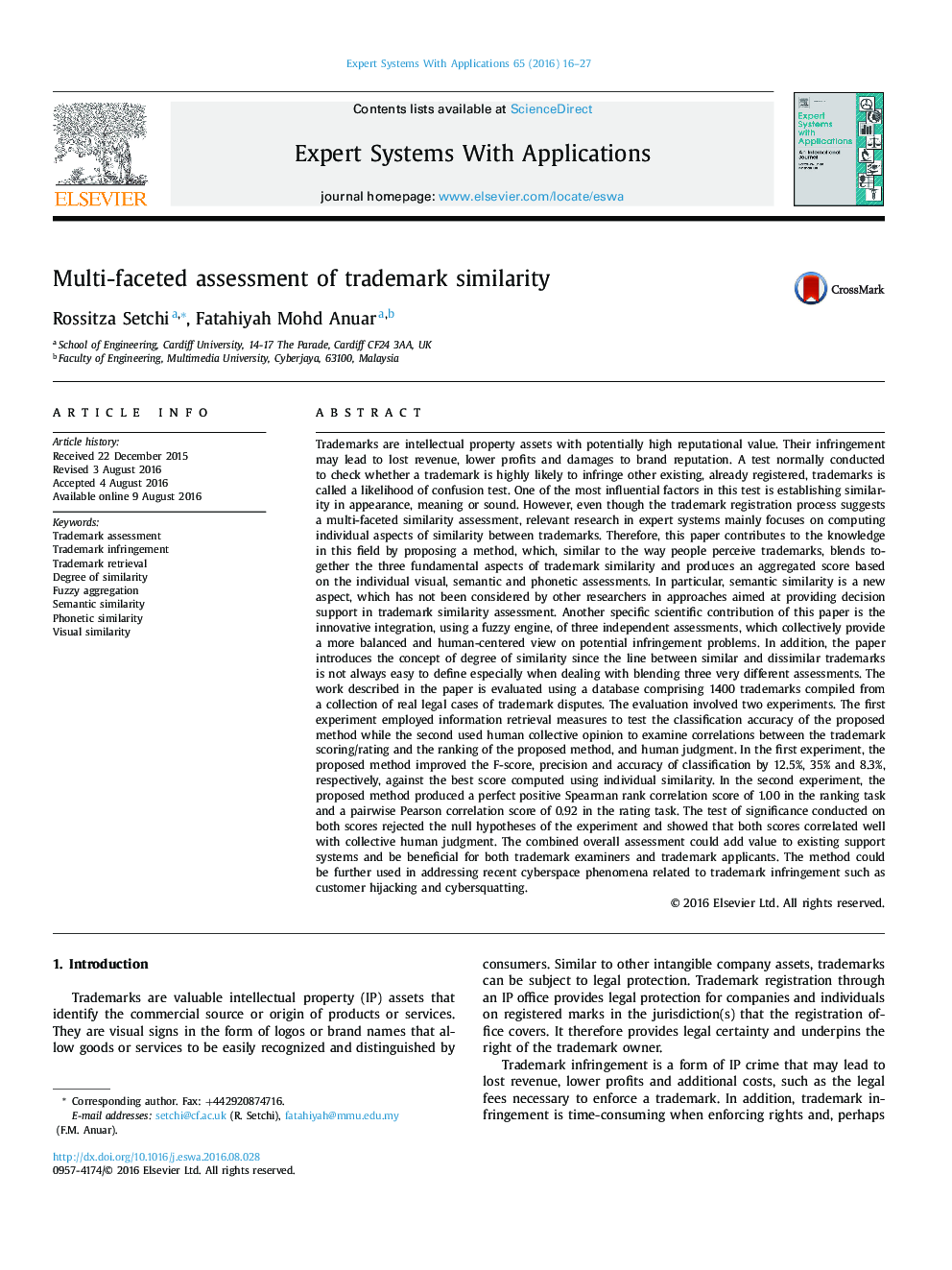| کد مقاله | کد نشریه | سال انتشار | مقاله انگلیسی | نسخه تمام متن |
|---|---|---|---|---|
| 6855426 | 1437641 | 2016 | 12 صفحه PDF | دانلود رایگان |
عنوان انگلیسی مقاله ISI
Multi-faceted assessment of trademark similarity
ترجمه فارسی عنوان
ارزیابی چند بعدی از شباهت علامت تجاری
دانلود مقاله + سفارش ترجمه
دانلود مقاله ISI انگلیسی
رایگان برای ایرانیان
کلمات کلیدی
ارزیابی علامت تجاری، نقض قوانین علامت تجاری، بازیابی علامت تجاری، درجه تشابه، تجمع فازی، شباهت معنایی، شباهت آوایی، شباهت بصری،
موضوعات مرتبط
مهندسی و علوم پایه
مهندسی کامپیوتر
هوش مصنوعی
چکیده انگلیسی
Trademarks are intellectual property assets with potentially high reputational value. Their infringement may lead to lost revenue, lower profits and damages to brand reputation. A test normally conducted to check whether a trademark is highly likely to infringe other existing, already registered, trademarks is called a likelihood of confusion test. One of the most influential factors in this test is establishing similarity in appearance, meaning or sound. However, even though the trademark registration process suggests a multi-faceted similarity assessment, relevant research in expert systems mainly focuses on computing individual aspects of similarity between trademarks. Therefore, this paper contributes to the knowledge in this field by proposing a method, which, similar to the way people perceive trademarks, blends together the three fundamental aspects of trademark similarity and produces an aggregated score based on the individual visual, semantic and phonetic assessments. In particular, semantic similarity is a new aspect, which has not been considered by other researchers in approaches aimed at providing decision support in trademark similarity assessment. Another specific scientific contribution of this paper is the innovative integration, using a fuzzy engine, of three independent assessments, which collectively provide a more balanced and human-centered view on potential infringement problems. In addition, the paper introduces the concept of degree of similarity since the line between similar and dissimilar trademarks is not always easy to define especially when dealing with blending three very different assessments. The work described in the paper is evaluated using a database comprising 1400 trademarks compiled from a collection of real legal cases of trademark disputes. The evaluation involved two experiments. The first experiment employed information retrieval measures to test the classification accuracy of the proposed method while the second used human collective opinion to examine correlations between the trademark scoring/rating and the ranking of the proposed method, and human judgment. In the first experiment, the proposed method improved the F-score, precision and accuracy of classification by 12.5%, 35% and 8.3%, respectively, against the best score computed using individual similarity. In the second experiment, the proposed method produced a perfect positive Spearman rank correlation score of 1.00 in the ranking task and a pairwise Pearson correlation score of 0.92 in the rating task. The test of significance conducted on both scores rejected the null hypotheses of the experiment and showed that both scores correlated well with collective human judgment. The combined overall assessment could add value to existing support systems and be beneficial for both trademark examiners and trademark applicants. The method could be further used in addressing recent cyberspace phenomena related to trademark infringement such as customer hijacking and cybersquatting.
ناشر
Database: Elsevier - ScienceDirect (ساینس دایرکت)
Journal: Expert Systems with Applications - Volume 65, 15 December 2016, Pages 16-27
Journal: Expert Systems with Applications - Volume 65, 15 December 2016, Pages 16-27
نویسندگان
Rossitza Setchi, Fatahiyah Mohd Anuar,
